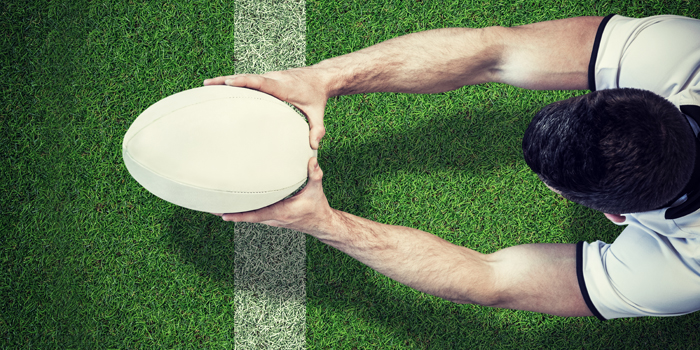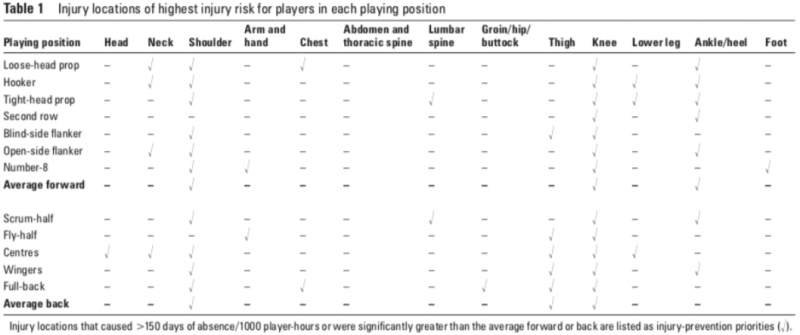
Back in 2013, I released an ebook through elitefts.com entitled Engineering Physical Performance, Strength Training for Rugby: A Neural, Mechanical & Metabolic Approach. In this ebook, I detailed my philosophies regarding strength training for rugby based on the three main determinants of success on the rugby field.
In designing programs for my players, I discuss with the player, the medical staff, and the coaching staff the areas they see as major ones to work on. I may decide after all of this input to assign each player to one of 10 programs based on the emphasis given to each of the three key areas of weight room programming.
Neural – Speed and Power
Mechanical – Size and Strength
Metabolic – Fitness and Muscular Endurance
I have used many week-long plans over the past 30 years, but recently, I have come back to a three-day-per-week plan training the full body in each training session, rather than in the many variations of split programs that are available. Full-body training allows the player to experience a greater degree of stimulus all week, and I can fine-tune this because I prefer to work in three weekly blocks of training.
RECENT: Pre-Season: Our Time to Shine
All weight training has a neural stimulus, as the nervous system activates the muscular system. In my programming, I use the term “neural” to outline more of a speed, power, and rate of force development style of training. The use of the term “mechanical” refers more to strength training (amount of force developed) and also to the development of an appropriate muscular size. Finally, “metabolic” refers more to conditioning than to strength and power, although these are developed concurrently. But the emphasis is on aerobic/anaerobic conditioning and on elements of muscular endurance.
As you can see below, I can allocate a specific program on a needs basis to each player across the squad. The content of each program may be balanced across all three elements. For example, program 1 involves working from the highest neural demand to the lowest over the three training days in the week-long plan. Alternatively, it could be completely skewed in favor of a particular aspect of the three primary training goals. But more than likely, the program will focus on bi-modal development with a certain element prioritized with two sessions over one of the secondary methods.
Here, then, are the 10 variations that I would program a player into:
- Neural, Mechanical & Metabolic (1 x Each training session)
- All Neural (3 x Neural training sessions)
- All Mechanical (3 x Mechanical training sessions)
- All Metabolic (3 x Metabolic training sessions)
- Neuro-Mechanical (2 x Neural, 1 x Mechanical)
- Neuro-Metabolic (2 x Neural, 1 x Metabolic)
- Mechano-Neural (2 x Mechanical, 1 x Neural)
- Mechano-Metabolic (2 x Mechanical, 1 x Metabolic)
- Meta-Neural (2 x Metabolic, 1 x Neural)
- Meta-Mechanical (2 x Metabolic, 1 x Mechanical)
In all training programs, there are a plethora of options available to you. Below are examples of each of my main programs for each of the primary elements in my system.
Neural Snap Shot
Preparation
Neural Activation Protocol (Hops, Jumps, Bounds, Short Sprints)
Weights
- Primary Power Exercise of choice (speed strength orientation), 5 x 3 @ 60%
- Depth Jump, 3 reps
- 10-meter Sprint through timing lights (done as a tri set, for 5 sets in total)
- Secondary Power Exercise of choice (strength-speed orientation), 4 x 4 @80%
- 3 Hurdle Jumps into a 20-meter Prowler® Push (done as a Super Set for 4 sets total)
- Primary Peak Force Movement (usually Squat or Deadlift), 3 x 2 @ 90%
Mechanical Snap Shot
Preparation
- Hip Mobility: Hurdles – 10 reps forward and backward, 10 reps unders and overs
- Lunge Combination – Backward, Forward & Lateral, 2 x 10 each side
Weights
- Primary Peak Force Movement(squat): 3 x (2/1) @ 90+% contrast Super Set with 3 x Knees to Feet Jumps each set
- Primary Peak Power Movement: 6 x 3 reps @ 70 – 80% contrast Super Set with 3 x repeat Long Jumps in each set
- Secondary Peak Force Movement (hinge): 3 x (2/1) @ 90+% contrast Super Set with 3 x Knees to Feet Jumps in each set
- Hamstring-Specific Movement: 3 x 6 reps
Weighted Core Circuit (3 times through)
½ Turkish Get-Up with KB x 5 each side/Band Barbell Rollouts x 10/Farmer's Walk Implement Suitcase Deadlift x 5 each side/Windmill x 5 each side
Metabolic Snap Shot
Preparation
Olympic Lifting Complexes Bar Only (6 reps of each movement) x 3
- Muscle Snatch from the Floor/Hang Power Snatch/Snatch Balance/Snatch Squat Press/Over Head Squat
- Clean Grip Power Snatch/Hang Power Clean/Front Squat/Sots Press/Push Press
- Hang Snatch/Push Press/Front Squat/Hang Clean/Bent Over Row/RDL
Weights
1: (Beast Circuit):
Dead Lift/Power Clean from Hang/Front Squat/Push Press/Bent Over Row/Romanian Dead Lift 45 seconds on Watt Bike going every 4 minutes
2: (Otago Circuit):
Row 300m in <1 minute/10 Full Burpees with Jump/10 x 36kg, 2 Arm Swings with KB/10 x Reverse Lunge each leg/10 x DB, Hang Clean/10kg, Med Ball Slam to Ground 10 each side x 4
3: (Loaded Carry Circuit):
50m Prowler®/50m Overhead Carry/50m Farmer’s Walk/50m Zercher Carry/Tyre Flip/12 Calories on Assault Bike x 6
Here are the new variations that I have been utilizing as part of the off-season program of the university rugby club that I am currently working with. These programs can be used across many levels of training and will greatly enhance the elements you are trying to develop.
Neural
Speed & Power Off-Season Program
1a. Loaded Sprint
1b. Velocity Power Movements
Choose 1: Jump Shrug/Hang High Pull/Mid-Thigh Power Clean or Snatch
1c. Unweighted Lower Body Plyometric Movements:
Choose 1: Box Jumps/Hops, Depth Jumps into Long Jump or Hurdle Jump, Repeat Long Jumps/Hops, Repeat Hurdle Jumps/Hops, Borzov Hops, Alternating Bench Blasts, Knees to Feet Jumps, Squat to Split.
2. Maximal Force Movements
Choose from either Squat or Deadlift option
3. Secondary Force Movements: If you chose Squat, do a single Leg Hinge; if you chose Deadlift, do a single Leg Squat.
4. Upper Body Push & Pull Super Set
Lower Body
Bilateral
Week 1 – 4 x 6 Week 2 – 4 x 4 Week 3 – 4 x 2
Unilateral
Week 1 – 4 x 12 Week 2 – 4 x 8 Week 3 – 4 x 4
Upper Body
Push: Week 1 – 4 x 6 Week 2 – 4 x 4 Week 3 – 4 x 2
Pull: Week 1 – 4 x 12 Week 2 – 4 x 8 Week 3 – 4 x 4
Core Accessory Rehab Exercise (CARE) Program:
2 x 10 reps on each
- 1 x Core: ½ Turkish Get-Up, Windmills, Rollouts, Suit Case Dead Lift, Combat Twist, Weighted Sit-Up
- 2 x Hips, Hamstrings, Calf & Knee: Copenhagen Plank, Lunge Complex, Nordics, 2 Bench Hip Thrusts, Calf Raise, Petersen Step Ups
- 1 x Shoulder/Rotator Cuff: Incline YTIs, Bottom-Up KB Press, Cuban Press, DB Scarecrow
- 1 x Neck: Wrestler’s Bridge 2 Ways, Neck Planks 3 Ways, Band Look Away
Mechanical
Strength & Size Off-Season Program
- 1 x Lower Body Push (Day 1 Bilateral, Day 2 Unilateral)
- 1 x Lower Body Pull (Hinge) (Day 1 Unilateral, Day 2 Bilateral)
- 1 x Upper Body Push & Pull (Super Set)
- 1 x Loaded Carry (Farmer’s Walk, Waiter’s Walk, Suitcase, Combo, Overhead)
Lower Body
Bilateral
Week 1 – 4 x 6 Week 2 – 4 x 4 Week 3 – 4 x 2
Unilateral
Week 1 – 4 x 12 Week 2 – 4 x 8 Week 3 – 4 x 4
Upper Body
Push: Week 1 – 4 x 6 Week 2 – 4 x 4 Week 3 – 4 x 2
Pull: Week 1 – 4 x 12 Week 2 – 4 x 8 Week 3 – 4 x 4
Armor Plating Upper Body Size Options
Big Back Maniac, Arms Race, Boulder Shoulders, Pectoral Punishment
My sincere thanks to Simon Price for his work in bringing these sessions to life; here is a link to the specific sessions.
Core Accessory Rehab Exercise Program (CARE):
2 x 10 reps on each
- 1 x Core: ½ Turkish Get-Up, Windmills, Rollouts, Suit Case Dead Lift, Combat Twist, Weighted Sit-Up
- 2 x Hips, Hamstrings, Calf & Knee: Copenhagen Plank, Lunge Complex, Nordics, 2 Bench Hip Thrusts, Calf Raise, Petersen Step-Ups
- 1 x Shoulder/Rotator Cuff: Incline YTIs, Bottom-Up KB Press, Cuban Press, DB Scarecrow
- 1 x Neck: Wrestler’s Bridge 2 Ways, Neck Planks 3 Ways, Band Look Away
Metabolic
Fitness & Endurance Off-Season Program
Day 1: (Beast Circuit):
Dead Lift/Power Clean from Hang/Front Squat/Push Press/Bent Over Row/Romanian Dead Lift 45 seconds on Watt Bike going every 4 minutes
Day 2: (Otago Circuit):
Row 300m in <1 minute/10 Full Burpees with Jump/10 x 36kg, 2 Arm Swings with KB/10 x Reverse Lunge each leg/10 x DB, Hang Clean/10kg, Med Ball Slam to Ground 10 each side x 4
Day 3: (Loaded Carry Circuit):
50m Prowler®/50m Overhead Carry/50m Farmer’s Walk/50m Zercher Carry/Tyre Flip/12 Calories on Assault Bike x 6
1 x Lower Body Push (Day 1 Bilateral, Day 2 Unilateral)
1 x Lower Body Pull (Hinge) (Day 1 Unilateral, Day 2 Bilateral)
1 x Upper Body Push & Pull (Super Set)
Lower Body
Bilateral
Week 1 – 4 x 6 Week 2 – 4 x 4 Week 3 – 4 x 2
Unilateral
Week 1 – 4 x 12 Week 2 – 4 x 8 Week 3 – 4 x 4
Upper Body
Push: Week 1 – 4 x 6 Week 2 – 4 x 4 Week 3 – 4 x 2
Pull: Week 1 – 4 x 12 Week 2 – 4 x 8 Week 3 – 4 x 4
Core Accessory Rehab Exercise (CARE) Program:
2 x 10 reps on each
- 1 x Core: ½ Turkish Get-Up, Windmills, Rollouts, Suit Case Dead Lift, Combat Twist, Weighted Sit-Up
- 2 x Hips, Hamstrings, Calf & Knee: Copenhagen Plank, Lunge Complex, Nordics, 2 Bench Hip Thrusts, Calf Raise, Petersen Step-Ups
- 1 x Shoulder/Rotator Cuff: Incline YTIs, Bottom-Up KB Press, Cuban Press, DB Scarecrow
- 1 x Neck: Wrestler’s Bridge 2 Ways, Neck Planks 3 Ways, Band Look Away
The CARE program is the same in each program, as it focuses on the specific areas that are most commonly injured in the game of rugby. The below table outlines these by position and is taken from an excellent article.

Injury-prevention priorities according to playing position in professional rugby union players
Injury-prevention priorities according to playing position in professional rugby union players JHMBrooks, SPTKemp (published online 2010). Here is a link to the article.











Another great article full of content, I found this really helpful as I am looking at how I can develop other qualities, mainly power and endurance. What I take away is that I can blend the methods up to now I was being a bit too linear and thinking that I would have to do a block on strength and then transition in to power, before reading this I "couldn't see the wood for the trees". I have a weekly conditioning session as part of one of the teams I'm on, but that still gives me options 1,4,6,8,9 and 10 from above so with a deload every 4th week I've got 24 weeks training to go at and I should be able to phase those to favour one quality depending on what I want to achieve.
I always look forward to these articles and this was brilliant for me. thank you.
Kind regards.
Marcus
Thank you for another great article.
I have a question about loading / intensity of lifts. (Sorry if I've missed this in here or in previous articles).
When you prescribe the sets & reps detailed above (copied below) - do you also provide lifting intensities - RPE / %1RM?
Lower Body - Bilateral
Week 1 – 4 x 6 Week 2 – 4 x 4 Week 3 – 4 x 2
Unilateral
Week 1 – 4 x 12 Week 2 – 4 x 8 Week 3 – 4 x 4
Upper Body
Push: Week 1 – 4 x 6 Week 2 – 4 x 4 Week 3 – 4 x 2
Pull: Week 1 – 4 x 12 Week 2 – 4 x 8 Week 3 – 4 x 4
Regards
Shane Tetzlaff